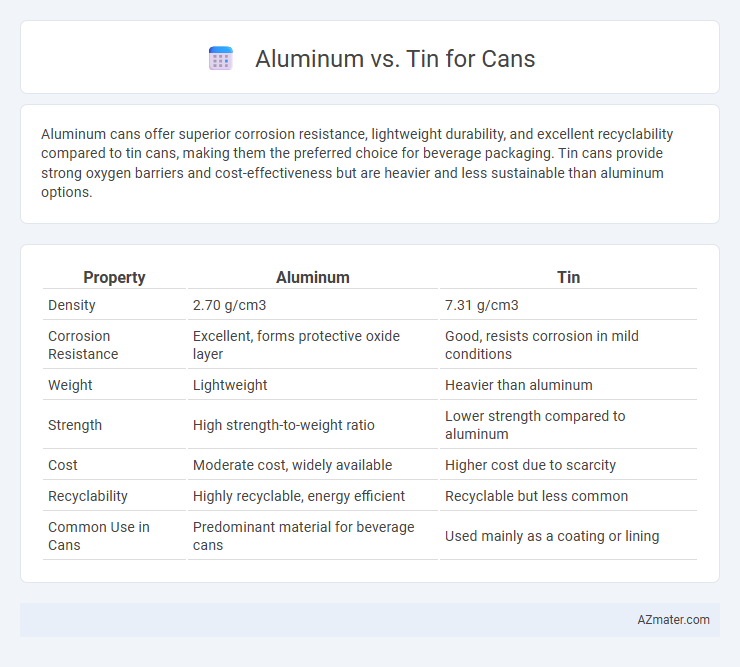Aluminum cans offer superior corrosion resistance, lightweight durability, and excellent recyclability compared to tin cans, making them the preferred choice for beverage packaging. Tin cans provide strong oxygen barriers and cost-effectiveness but are heavier and less sustainable than aluminum options.
Table of Comparison
| Property | Aluminum | Tin |
|---|---|---|
| Density | 2.70 g/cm3 | 7.31 g/cm3 |
| Corrosion Resistance | Excellent, forms protective oxide layer | Good, resists corrosion in mild conditions |
| Weight | Lightweight | Heavier than aluminum |
| Strength | High strength-to-weight ratio | Lower strength compared to aluminum |
| Cost | Moderate cost, widely available | Higher cost due to scarcity |
| Recyclability | Highly recyclable, energy efficient | Recyclable but less common |
| Common Use in Cans | Predominant material for beverage cans | Used mainly as a coating or lining |
Introduction: Aluminum vs Tin Cans
Aluminum cans offer superior corrosion resistance, lightweight design, and excellent recyclability compared to traditional tin cans, making them a preferred choice for beverage packaging. Tin cans, made primarily from steel coated with tin, provide durability and strong protection against contamination but tend to be heavier and less environmentally sustainable than aluminum alternatives. The shift towards aluminum is driven by its enhanced cost-effectiveness, faster production cycles, and reduced environmental impact in the can manufacturing industry.
Historical Evolution of Can Materials
Aluminum replaced tin as the dominant can material in the mid-20th century due to its lightweight and corrosion-resistant properties, which improved transportation efficiency and product shelf-life. Early cans in the 19th century were primarily tin-plated steel, offering durability but prone to rust and heavier weight. The shift to aluminum revolutionized packaging, aligning with advancements in metallurgy and mass production techniques.
Physical Properties: Aluminum and Tin Compared
Aluminum offers a lightweight structure with excellent corrosion resistance and high tensile strength, making it ideal for beverage cans that require durability and easy recyclability. Tin, though heavier and less resistant to corrosion, provides superior malleability and a smoother finish, often used for decorative or specialty packaging. The thermal conductivity of aluminum outperforms tin, enhancing heat dissipation during cooling processes, which is crucial for beverage storage.
Manufacturing Processes of Aluminum and Tin Cans
Aluminum cans are manufactured through a process called impact extrusion, where a slug of aluminum is shaped by a punch into a seamless can body, followed by trimming, washing, and printing. Tin cans undergo a different process involving tin-plated steel sheets that are cut, formed into body shells, welded or soldered to create a cylindrical shape, and then coated to prevent corrosion. The aluminum process enables lightweight, corrosion-resistant, and recyclable packaging, while tin can manufacturing emphasizes durability and barrier protection against contamination.
Cost and Market Availability
Aluminum cans generally cost more to produce than tin cans due to higher raw material prices and energy-intensive manufacturing processes. Despite the higher cost, aluminum dominates the market because of its lightweight properties, superior recyclability, and widespread availability from large-scale mining operations. Tin cans remain less common but are still used in niche applications where corrosion resistance is prioritized, benefiting from steady but limited market availability.
Environmental Impact and Recycling Efficiencies
Aluminum cans have a significantly lower environmental impact due to their high recycling efficiency, with a global recycling rate averaging around 69%, which conserves 95% of the energy required for primary production. Tin cans, primarily made from steel with a tin coating, exhibit recycling rates of about 70%, but their energy savings are less pronounced compared to aluminum because steel production is more energy-intensive. Aluminum's lightweight nature reduces transportation emissions, further enhancing its environmental benefits over tin in the beverage and food packaging industry.
Food Safety and Preservation Capabilities
Aluminum cans provide superior corrosion resistance and form a passive oxide layer that prevents metal leaching, ensuring optimal food safety and flavor preservation. Tin cans, while historically popular, are more prone to corrosion and require additional coatings to prevent contamination and extend shelf life. The impermeability and structural strength of aluminum enhance its ability to maintain food freshness and prevent oxidation compared to tin.
Applications in the Food and Beverage Industry
Aluminum cans dominate the food and beverage industry due to their lightweight nature, superior corrosion resistance, and excellent recyclability, making them ideal for soft drinks, beer, and ready-to-eat meals. Tin-plated steel cans are preferred for shelf-stable products like canned vegetables and meats, offering strong structural integrity and effective protection against microbial contamination. The choice between aluminum and tin depends on product requirements such as shelf life, preservation needs, and manufacturing costs.
Consumer Preferences and Trends
Consumers increasingly favor aluminum cans due to their superior recyclability, lighter weight, and enhanced durability compared to tin cans. Market trends highlight a growing demand for environmentally sustainable packaging, with aluminum's 100% recyclability and energy-efficient production processes aligning with eco-conscious values. Tin cans, despite their traditional appeal and excellent corrosion resistance, face declining preference as consumers prioritize convenience and sustainability.
Future Outlook: Innovations in Can Materials
Advancements in can technology prioritize sustainability, with aluminum leading due to its recyclability and lightweight properties, reducing carbon footprints across the supply chain. Research into bio-based coatings and enhanced aluminum alloys aims to improve durability and taste preservation, driving the next generation of beverage packaging. Although tin offers excellent corrosion resistance, aluminum's superior material innovations and expanding recycling infrastructure forecast a dominant role in future can manufacturing.

Infographic: Aluminum vs Tin for Can
 azmater.com
azmater.com